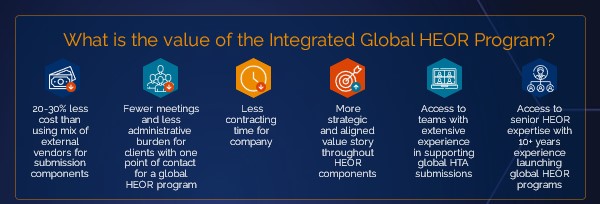Author: Kirk Szafranski, Director, HEOR, Value & Evidence
Health Economics and Outcomes Research (HEOR) programs play a pivotal role in assessing a product’s value, cost-effectiveness, and real-world impact on patient outcomes, which are critical factors influencing reimbursement decisions, formulary placements, and overall market access. A global integrated HEOR program typically includes a range of components and activities, including but not limited to:
- Systematic Literature Reviews (SLRs): Comprehensive and systematic reviews of existing published literature related to the product, its therapeutic area, and relevant comparators. SLRs help gather evidence on clinical effectiveness, safety, and patient outcomes.
- Global Value Dossier (GVD) Development: The creation of a comprehensive document that outlines the product’s value proposition, clinical and economic evidence, and its differentiation from competing treatments. The GVD is essential for market access and reimbursement discussions.
- Indirect Treatment Comparisons (ITCs): Comparative analyses that use indirect evidence to compare the product’s effectiveness and safety with other treatments, especially when head-to-head clinical trial data are not available
- Economic Models: The development of economic models, such as cost-effectiveness and budget impact models, which assess the economic implications of adopting the product in different healthcare settings.
In the ever-evolving landscape, pharmaceutical manufacturers are increasingly recognizing the importance of HEOR in showcasing the value of their products to stakeholders worldwide. As the global market expands, manufacturers face critical decisions on how to structure their HEOR initiatives effectively. In this blog post, we will explore two distinct scenarios that manufacturers may encounter when implementing a global integrated HEOR program.
Imagine This: The Divergent Paths of Manufacturers Implementing a Global Integrated HEOR Program
Scenario 1: The Fragmented Approach
Imagine a pharmaceutical manufacturer launching a groundbreaking medical intervention and seeking to establish its value on a global scale. In this scenario, the manufacturer decides to opt for a fragmented approach, engaging multiple HEOR vendors for different components of their program, such as SLRs, GVD development, ITCs and economic models.
At first glance, this approach may seem feasible, as each specialized vendor can deliver expertise in their respective areas. However, as the project unfolds, challenges begin to emerge. The manufacturer finds themselves juggling multiple contracts and invoices, resulting in a cumbersome administrative burden. Frequent meetings with each vendor lead to fragmented communications and a lack of holistic oversight.
Additionally, coordinating between separate teams becomes increasingly difficult, resulting in misalignment in value messaging and potentially compromising the overall value story. As teams seek clarifications or request modifications from one another, the manufacturer is burdened with acting as an intermediary, impeding the efficiency of the process.
Scenario 2: The Unified Solution

Now, picture a different pharmaceutical manufacturer embarking on a similar global HEOR program for their innovative product. In this scenario, the manufacturer decides to take a unified approach by partnering with a single integrated HEOR vendor that covers all aspects of their program, including SLRs, GVD, ITCs and economic models.
From the outset, this integrated approach proves to be a game-changer. With a single vendor handling all components, the manufacturer streamlines contractual and administrative processes, reducing the time and effort spent on managing multiple vendors. There are far fewer meetings required, as the various teams can collaborate seamlessly and share insights to create a consistent and coherent value story.
Strategic alignment becomes the cornerstone of this unified approach. The integrated vendor ensures that all components of the program work in synergy, enhancing the overall impact and value messaging. Teams communicate directly with each other, facilitating quick coordination without the need for constant intervention from the manufacturer.
The manufacturer benefits from package discounts offered by the integrated vendor, leading to potential cost savings. The ability to leverage efficiencies across multiple workstreams enables the manufacturer to optimize their HEOR budget effectively.
Conclusion: Why Choose EVERSANA?
A new product launch necessitates integrated global HEOR programs to achieve a successful market entry and sustained growth in today’s competitive and complex healthcare landscape. EVERSANA’s Value & Evidence team has extensive experience implementing all pieces of an integrated global HEOR program.
By partnering with EVERSANA and their industry-leading integrated global HEOR program team, manufacturers can gather robust evidence across multiple markets, at less cost and more efficiently while also receiving a more cohesive strategy and value story for their new assets. This integrated approach enhances a product’s credibility and market adoption while providing crucial insights to stakeholders, ultimately driving better-informed decision-making and ensuring the product’s long-term success in the global market.
Contact us to learn more about EVERSANA’s global integrated HEOR program offers.

